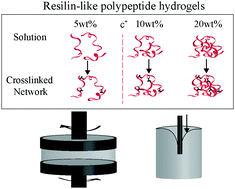Micromechanical characterization of soft, biopolymeric hydrogels: stiffness, resilience, and failure†
Abstract
Detailed understanding of the local structure–property relationships in soft biopolymeric hydrogels can be instrumental for applications in regenerative tissue engineering. Resilin-like polypeptide (RLP) hydrogels have been previously demonstrated as useful biomaterials with a unique combination of low elastic moduli, excellent resilience, and cell-adhesive properties. However, comprehensive mechanical characterization of RLP hydrogels under both low-strain and high-strain conditions has not yet been conducted, despite the unique information such measurements can provide about the local structure and macromolecular behavior underpinning mechanical properties. In this study, mechanical properties (elastic modulus, resilience, and fracture initiation toughness) of equilibrium swollen resilin-based hydrogels were characterized via oscillatory shear rheology, small-strain microindentation, and large-strain puncture tests as a function of polypeptide concentration. These methods allowed characterization, for the first time, of the resilience and failure in hydrogels with low polypeptide concentrations (<20 wt%), as the employed methods obviate the handling difficulties inherent in the characterization of such soft materials via standard mechanical techniques, allowing characterization without any special sample preparation and requiring minimal volumes (as low as 50 μL). Elastic moduli measured from small-strain microindentation showed good correlation with elastic storage moduli obtained from oscillatory shear rheology at a comparable applied strain rate, and evaluation of multiple loading-unloading cycles revealed decreased resilience values at lower hydrogel concentrations. In addition, large-strain indentation-to-failure (or puncture) tests were performed to measure large-strain mechanical response and fracture toughness on length scales similar to biological cells (∼10–50 μm) at various polypeptide concentrations, indicating very high fracture initiation toughness for high-concentration hydrogels. Our results establish the utility of employing microscale mechanical methods for the characterization of the local mechanical properties of biopolymeric hydrogels of low concentrations (<20 wt%), and show how the combination of small and large-strain measurements can provide unique insight into structure–property relationships for biopolymeric elastomers. Overall, this study provides new insight into the effects on local mechanical properties of polypeptide concentration near the overlap polymer concentration c* for resilin-based hydrogels, confirming their unique elastomeric features for applications in regenerative medicine.



 Please wait while we load your content...
Please wait while we load your content...